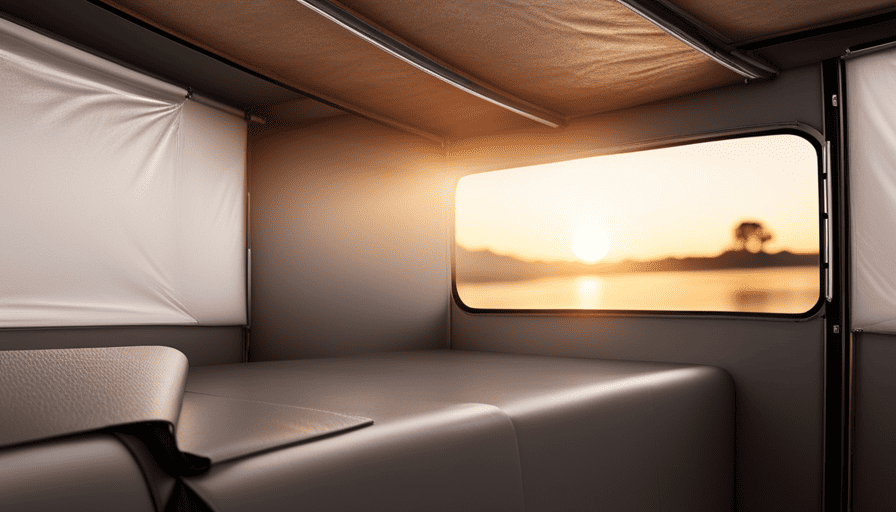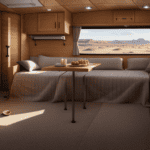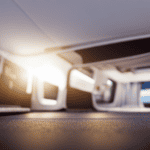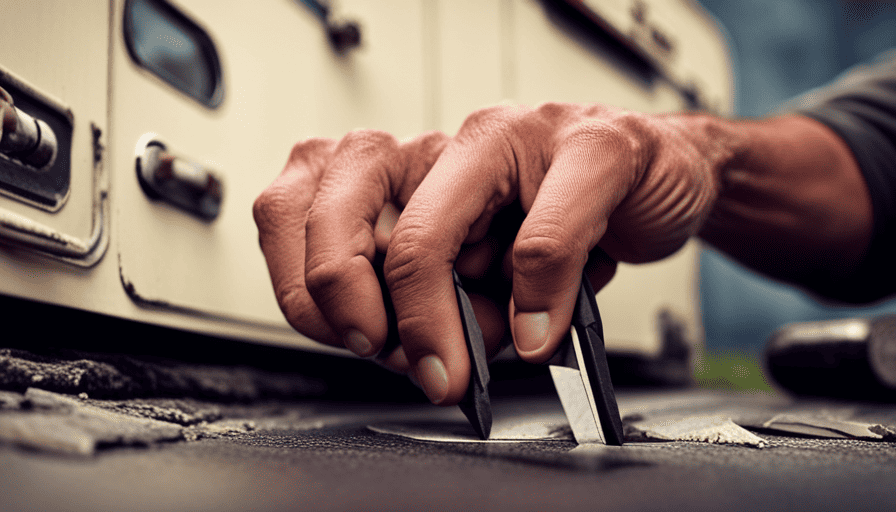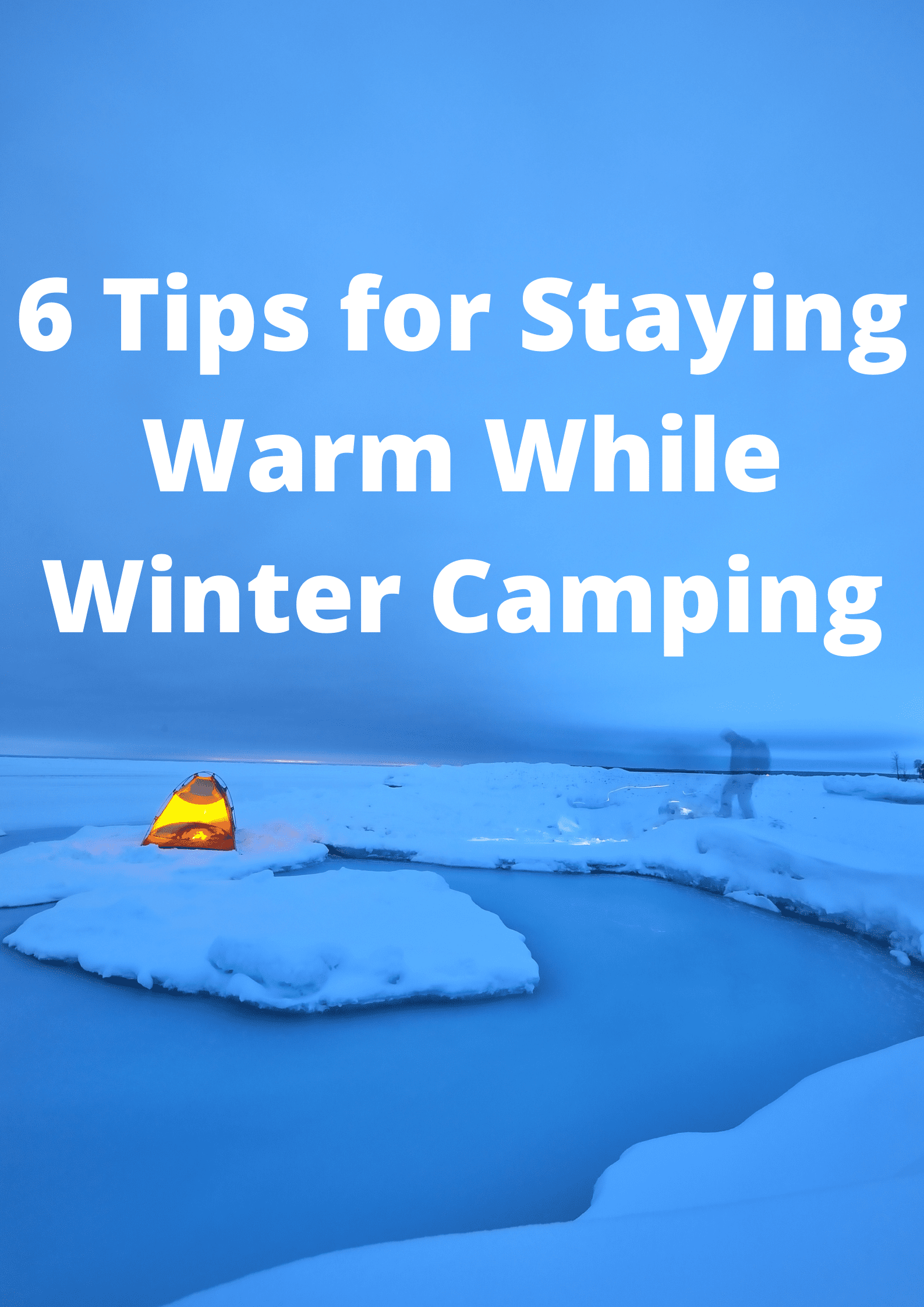You may be wondering – why should I insulate my pop-up camper? Isn’t it designed to keep me warm and comfortable during my camping adventures?
Well, while pop up campers are certainly great for enjoying the great outdoors, their insulation can often leave something to be desired. That’s why I’m here to share with you some valuable tips and tricks on how to insulate your pop up camper.
In this article, I will guide you through the process of assessing your camper’s insulation needs, choosing the right materials, and sealing any gaps and air leaks.
I will also show you how to install reflective insulation, use insulated curtains or blinds, and consider insulating pipes and tanks. Additionally, I’ll provide you with insights on using space heaters or portable radiators, ventilating properly to prevent condensation, and testing and monitoring the efficiency of your insulation.
By the end of this article, you’ll have all the knowledge and tools necessary to transform your pop up camper into a cozy haven, no matter the weather outside.
So, let’s get started and make your camping experience even more enjoyable and comfortable!
Key Takeaways
- Assess insulation needs based on climate conditions, current insulation, and camping habits
- Insulate walls, ceiling, and floor for maximum coziness
- Properly insulate windows and doors
- Regularly test and monitor insulation efficiency
Assess Your Pop Up Camper’s Insulation Needs
You’ll want to take a close look at your pop up camper to determine how much insulation it really needs. Evaluating the insulation requirements of your camper is essential to create a comfortable and energy-efficient space. Here are some tips for evaluating insulation in your pop up camper.
Firstly, consider the climate conditions you’ll be camping in. If you plan to camp in colder regions, you’ll need more insulation to keep the interior warm. On the other hand, if you often camp in hot climates, insulation can help keep the interior cool and prevent heat from entering.
Next, inspect the current insulation in your pop up camper. Look for any signs of wear and tear, such as gaps, cracks, or thin spots. These areas may require additional insulation or repairs to ensure optimal insulation performance.
Additionally, consider the type of camping you usually engage in. If you camp year-round, you may require more insulation compared to someone who only camps during certain seasons. Assessing your specific camping habits will help determine the insulation needs of your pop up camper.
Evaluating insulation requirements is crucial for a comfortable camping experience. Once you’ve assessed your pop up camper’s insulation needs, you can move on to choosing the right insulation materials for the job.
Choose the Right Insulation Materials
When choosing insulation materials for your pop up camper, it’s important to consider the R-Value and insulation types. The R-Value measures the effectiveness of the insulation in preventing heat transfer, so a higher R-Value means better insulation.
Additionally, you’ll want to insulate the walls, ceiling, and floor to create a comfortable and well-insulated living space. By carefully selecting the right insulation materials and properly insulating these areas, you can ensure that your pop up camper is well equipped to handle any weather conditions.
Consider R-Value and Insulation Types
To really amp up the cozy factor in your pop-up camper, go for insulation types with a high R-value. It’s like a warm and snuggly blanket protecting you from the chilly outside world. The R-value is a measure of how well an insulation material can resist heat flow. Higher R-values indicate better insulation performance.
When comparing insulation types, it’s important to consider their benefits. Fiberglass insulation, for example, is affordable and easy to install, but it may not be as effective as other options. Spray foam insulation, on the other hand, provides excellent thermal insulation and seals air leaks, but it can be more expensive.
Ultimately, the choice of insulation type will depend on your budget and specific needs.
Now let’s dive into how to insulate the walls, ceiling, and floor of your pop-up camper.
Insulate Walls, Ceiling, and Floor
For maximum coziness, make sure the walls, ceiling, and floor of your pop-up camper are properly insulated. Insulating these areas not only helps to regulate the temperature inside, but also provides soundproofing and protection against the elements.
When it comes to insulating techniques, there are a few options to consider. One popular choice is to use foam insulation boards, which can be easily cut to fit the walls, ceiling, and floor of your camper. Another option is to use reflective insulation, which helps to reflect heat away from the camper in hot weather and retains warmth in cold weather.
When choosing insulation materials, it’s important to consider cost as well. Foam insulation boards tend to be more expensive, but provide better insulation, while reflective insulation is more affordable but may not be as effective in extreme temperatures.
To ensure maximum efficiency, it’s important to seal any gaps and air leaks in the camper, which will be discussed in the subsequent section.
Seal Any Gaps and Air Leaks
When it comes to sealing any gaps and air leaks in a pop-up camper, there are a few key points to keep in mind. First, using weatherstripping and caulk is essential to prevent drafts and keep the interior temperature regulated.
Additionally, insulating windows and doors can make a significant difference in reducing air leakage and improving overall insulation.
By paying attention to these details, you can ensure a more comfortable and energy-efficient camping experience in your pop-up camper.
Use Weatherstripping and Caulk
One effective way to keep the elements out of your pop up camper is by using weatherstripping and caulk. When it comes to insulation techniques for pop up campers, it’s crucial to seal any gaps and air leaks.
Weatherstripping is a great tool to use around windows, doors, and any other openings to prevent air from entering or escaping. It creates a tight seal that keeps the interior temperature comfortable and prevents drafts.
Caulk is another essential component of proper insulation. It’s used to seal gaps and cracks in the walls and roof of the camper. By applying weatherstripping and caulk, you can significantly improve the insulation of your pop up camper, ensuring a cozy and energy-efficient space.
Now let’s move on to how to insulate windows and doors without compromising their functionality.
Insulate Windows and Doors
To effectively maintain a comfortable and energy-efficient environment inside your camper, you should focus on properly insulating the windows and doors. When it comes to insulating doors, using weatherstripping is key. This flexible material fills gaps and prevents drafts, ensuring that the cold air stays out and the warm air stays in. Additionally, caulking around the door frame can further enhance insulation by sealing any cracks or openings.
To prevent heat loss from windows, there are a few steps you can take. First, consider using thermal curtains or blinds to provide an extra layer of insulation. These can help block out cold air and keep warmth inside. Another option is to apply window film, which can help reflect heat back into the camper. Lastly, using window insulation kits with plastic film can create an airtight seal, reducing heat loss even further.
Next, we will discuss how to install reflective insulation, which is another effective method for insulating your pop-up camper.
Install Reflective Insulation
Reflective insulation is a great way to keep your pop up camper cozy and comfortable. It offers numerous benefits that make it an excellent choice for insulating your camper. First and foremost, reflective insulation helps to reduce heat transfer, keeping the interior cool in hot weather and warm in cold weather. This is achieved through the use of a reflective surface that reflects radiant heat away from the camper.
Not only is reflective insulation effective for pop up campers, but it can also be installed in other types of vehicles such as RVs and trailers. Its lightweight nature makes it easy to install, and it can be cut to fit any size or shape. Additionally, reflective insulation is durable and long-lasting, ensuring that it will continue to provide insulation for years to come.
To install reflective insulation in your pop up camper, start by measuring the dimensions of your walls and ceiling. Cut the reflective insulation to the appropriate size and attach it using adhesive or staples. Be sure to cover all areas, including windows and doors, to maximize the insulation’s effectiveness.
In the next section, we will discuss another method of insulating your pop up camper: using insulated curtains or blinds. These can further enhance the insulation by blocking out drafts and keeping the interior temperature regulated.
Use Insulated Curtains or Blinds
Make your camping experience even more comfortable by installing insulated curtains or blinds in your cozy camper. Insulated curtains or blinds are a great option for keeping the temperature inside your pop-up camper regulated, ensuring that you stay warm in the winter and cool in the summer.
Here are some pros and cons of using insulated curtains or blinds:
-
Pros:
-
They provide an additional layer of insulation, helping to reduce heat loss or gain through the windows.
-
They can help block out sunlight, giving you a darker and more restful sleep.
-
They’re easy to install and can be customized to fit any window size.
-
Cons:
-
They may not provide as much insulation as other methods, such as reflective insulation or foam board.
-
They may not completely block out all light, particularly if they’re not fitted properly.
-
They may not be as effective in extreme weather conditions.
While insulated curtains or blinds are a good option, there are also alternative insulation options for pop-up campers. These include using reflective insulation, foam board, or even adding an insulated skirt or belly band to further protect against heat loss.
By incorporating insulated curtains or blinds into your camper, you can create a more comfortable and energy-efficient environment. Speaking of insulation, let’s move on to the next section and discuss how to add an insulated skirt or belly band to your pop-up camper.
Add an Insulated Skirt or Belly Band
Enhance your camping experience with the addition of an insulated skirt or belly band. These additions will create a cozy and energy-efficient environment inside your cozy home on wheels.
An insulated skirt is a protective barrier that wraps around the bottom of your pop-up camper. It provides extra insulation to keep the interior warm in cold weather and cool in hot weather. Additionally, it helps to prevent drafts and reduce heat loss. The benefits of using an insulating skirt are numerous. Not only does it improve the overall comfort of your camper, but it also helps to save on energy costs by reducing the need for excessive heating or cooling.
Installing a belly band is another effective way to insulate your pop-up camper. A belly band is a strip of insulation that is applied directly to the exterior of the camper. It creates a barrier against the elements, sealing any gaps or openings. This prevents cold air from entering and warm air from escaping. As a result, the interior temperature remains stable, and the workload on your heating or cooling system is reduced.
To further improve the energy efficiency of your pop-up camper, consider insulating pipes and tanks. By insulating these components, you can prevent them from freezing in cold weather and reduce heat loss. This ensures a reliable water supply and minimizes the need for additional heating.
Consider Insulating Pipes and Tanks
Don’t be a frozen popsicle! Keep those pipes and tanks cozy with some insulation to ensure a steady flow of water and avoid turning your camper into an ice palace.
Insulating pipes and tanks in a pop-up camper is crucial for maintaining functionality and preventing freezing during colder temperatures. By doing so, you can ensure that you have access to running water and avoid any potential damage to your plumbing system.
The importance of insulating pipes and tanks cannot be overstated. When exposed to freezing temperatures, water inside the pipes can expand and cause them to burst, leading to costly repairs. Insulating these components helps maintain a consistent temperature and prevents freezing, allowing for a reliable water supply.
There are various techniques for insulating pipes and tanks in a pop-up camper. One effective method is to use foam pipe insulation, which can easily be wrapped around the pipes to provide a barrier against the cold. Another option is to use heat tape, which is specifically designed to keep pipes warm in freezing conditions. Additionally, insulating blankets or jackets can be used to wrap around tanks, providing an extra layer of insulation.
By properly insulating your pipes and tanks, you can ensure that you have a reliable water supply and avoid any potential damage. Once you’ve taken these measures, it’s important to consider additional steps such as using space heaters or portable radiators to keep the interior of your pop-up camper warm and comfortable.
Use Space Heaters or Portable Radiators
Using space heaters or portable radiators can significantly improve the overall comfort and warmth inside your pop-up camper during colder temperatures. When it comes to choosing between space heaters and portable radiators, there are a few factors to consider.
Space heaters are typically more energy efficient, as they’re designed to heat small spaces efficiently. They use electricity or propane to generate heat and can be easily adjusted to maintain a desired temperature. On the other hand, portable radiators work by heating oil or water and then radiating the heat into the surrounding area. While they may take longer to warm up a space, they’re known for providing a more consistent and even heat distribution.
Regardless of which option you choose, it’s important to use caution and follow safety guidelines. Make sure to keep flammable items away from the heater or radiator, and never leave them unattended. Additionally, it’s crucial to ventilate properly to prevent condensation buildup. This can be achieved by cracking a window or using a vent fan to circulate air.
By using space heaters or portable radiators in conjunction with proper ventilation, you can create a cozy and comfortable environment inside your pop-up camper, even during chilly weather.
Transitioning into the next section, ventilating properly is essential to prevent condensation and maintain a healthy interior environment.
Ventilate Properly to Prevent Condensation
To ensure you don’t turn your pop-up camper into a damp and musty sauna, it’s absolutely crucial that you properly ventilate to prevent condensation from wreaking havoc on your cozy little home away from home. Here are three key steps to help you prevent mold growth and control humidity levels in your camper:
-
Use vent fans: Installing vent fans in your pop-up camper can greatly improve air circulation and prevent excessive moisture buildup. These fans will help draw out humid air and replace it with fresh air from outside, reducing the chance of condensation.
-
Open windows and doors: Whenever weather conditions permit, open windows and doors to allow fresh air to flow through your camper. This will help regulate humidity levels and prevent stale air from becoming trapped inside, reducing the risk of mold growth.
-
Use dehumidifiers: Consider using portable dehumidifiers to further control moisture levels inside your pop-up camper. These devices work by extracting excess moisture from the air, reducing the likelihood of condensation and mold growth.
By following these ventilation tips, you can prevent condensation and maintain a comfortable, dry environment inside your pop-up camper.
In the next section, we will discuss how to test and monitor the efficiency of your insulation.
Test and Monitor the Efficiency of Your Insulation
Make sure you regularly test and monitor how well your insulation is working to keep your cozy camping space comfortable and energy-efficient. Efficient insulation is crucial to maintain a comfortable temperature inside your pop-up camper, especially during extreme weather conditions. By conducting efficiency testing and insulation monitoring, you can identify any areas that may need improvement and take necessary measures to enhance the insulation performance.
One effective way to test insulation efficiency is by using a thermal imaging camera. This device can detect temperature differences and identify any heat loss or cold spots in your camper. By scanning the walls, windows, and doors, you can pinpoint areas where the insulation may be lacking or damaged. Another method is to use a handheld infrared thermometer to measure the surface temperature of different areas within your camper. Significant variations in temperature can indicate insulation issues.
To monitor the insulation efficiency over time, you can create a simple table to record your findings. Here’s an example:
| Area Tested | Temperature Reading | Insulation Performance |
|---|---|---|
| Walls | 70°F | Good |
| Windows | 65°F | Fair |
| Doors | 75°F | Excellent |
| Roof | 80°F | Needs improvement |
Regularly testing and monitoring your insulation will help ensure that your pop-up camper remains energy-efficient and comfortable throughout your camping adventures.
Frequently Asked Questions
What are the benefits of insulating a pop up camper?
Insulating a pop-up camper offers numerous benefits. Firstly, it helps regulate the temperature inside, keeping it comfortable in both hot and cold weather. This can significantly improve the overall camping experience.
Effective insulation also reduces noise transmission from outside, ensuring a peaceful and relaxing environment. Additionally, it helps minimize condensation and moisture buildup, preventing mold and mildew growth.
To achieve effective insulation, consider using materials like foam board, reflective insulation, and weatherstripping to seal any gaps or leaks.
How do I determine if my pop up camper needs insulation?
To determine if your pop up camper needs insulation, consider the climate you’ll be camping in. If you plan to camp in colder temperatures, insulation is essential to keep you warm. Look for signs of heat loss, such as drafts or condensation.
Choosing the right insulation material is crucial. Fiberglass or foam board insulation are common options. Consider factors like R-value, durability, and ease of installation when selecting the best insulation for your camper.
Can I use regular household insulation materials for my pop up camper?
They say that necessity’s the mother of invention, and when it comes to insulating my pop up camper, I couldn’t agree more. While regular household insulation materials may seem like a convenient option, it’s important to consider the unique needs of a camper. Insulating materials designed specifically for RVs, such as foam boards or reflective insulation, are recommended for their durability and ability to withstand the elements. However, there are alternative options available, such as thermal curtains or bubble wrap, that can provide some insulation in a pinch.
How do I seal gaps and air leaks in my pop up camper?
To seal gaps and air leaks in my pop-up camper, I employ various sealing techniques. First, I thoroughly inspect the common air leak areas such as windows, doors, vents, and seams. Then, I use weatherstripping to seal the gaps around these areas.
Additionally, I apply silicone caulk to seal any small cracks or holes. Finally, I use foam insulation to seal larger gaps and ensure a tight seal. By addressing these areas, I can effectively prevent air leaks and maintain a comfortable interior temperature.
Will insulating my pop up camper help with noise reduction?
Insulating a pop-up camper can indeed help with noise reduction. There are various noise reduction techniques that can be used when insulating, such as sealing gaps and air leaks. Additionally, choosing the right insulation material can make a difference. Some alternative insulation materials, like acoustic foam or mass-loaded vinyl, are specifically designed to absorb and reduce noise. By properly insulating your pop-up camper, you can create a quieter and more comfortable space for yourself while camping.
Conclusion
In conclusion, insulating a pop up camper is an important step to ensure comfort and energy efficiency while camping. By properly assessing the insulation needs, choosing the right materials, and sealing any gaps, you can create a cozy and well-insulated space.
For example, I recently helped a friend insulate their pop up camper using reflective insulation and insulated curtains. Not only did they notice a significant improvement in keeping the heat in during colder nights, but they also saw a reduction in condensation build-up.
With the right insulation, you can enjoy camping in your pop up camper all year round.

